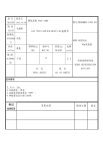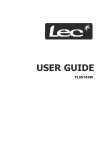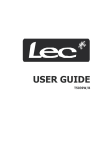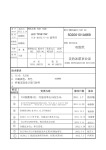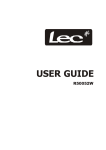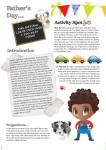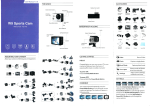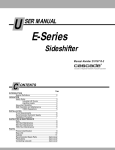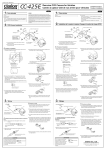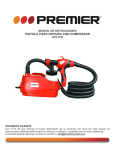Download LEC U5010
Transcript
U5010W Introduction Thank you for buying this high quality appliance! This handbook is designed to help you through each step of owning your new appliance, from installation, to use. Please read through all of this guide carefully before you start using your appliance, as we have endeavoured to answer as many questions as possible, and provide you with as much support as we can. If, however, you should find something missing, or not covered, please contact the Lec Customer Care team who will be only too happy to assist you on: 0871 505 084422 81522 3737 Our policy is one of constant development and improvement, therefore we cannot guarantee the strict accuracy of all of our illustrations and specifications changes may have been made subsequent to publishing. Contents For your safety .......................................................................................................... 1 About your product .................................................................................................... 3 Installing your appliance............................................... 4 Using your appliance................................................. 5 Care& cleanin 8 Troubleshooting..................................................... 9 Reversing the door.................................................. 10 Changing the plug.................................................. 11 Service record and Customer Care ................................................................ Backcover For Your Safety Disposal of old appliances Before disposin g of an old appliance , make sure that you have broken off, or disabled any locking mechanism s to preven t children becomin g accidentall y locked inside. Remov e any plugs and power leads to ensure that the applianc e is inoperative. Please note: This symbol means that products bearing it may not be dispose d of with household waste. The refrigeration system contain s insulatin g gases and refrigeran t which will require specialis t disposal . Most component s can be recycled . Alway s contact your local council or authorit y for informatio n regardin g the correct disposal/remo val of old appliances, do not dispose of with household waste. Warning: When disposin g of an old appliance make sure that the pipe work does not become damaged. Packaging All of the packagin g supplied with your applianc e can be recycled, or dispose d of without any harm to the environment. Cardboar d ma y be crushed , or cu t int o smalle r piece s if required for recycling or disposal . The polythen e and polystyrene included contain no CFC’s , and are environmentally friendly. For further informatio n on recycling, contact your local council or authority. Before installing and using your new appliance Read through the instruction s supplied with your appliance- failure to install or use this appliance in accordan ce with the instruction book may invalidate any warranty. The manufacture r does not accept any liability for damage caused through imprope r use, or incorrect installation. Do no t install this appliance if it has been damaged during transport ation. This includes the plug and powe r suppl y cord. Alway s install this appliance in line with these instructions. Always rea d these instruction s fully before using the applianc e for the first time. 1 For Your Safety Warning: Do not allow the refrigerant circuit to become damaged while using or installing. Should it become damaged, do not use the appliance until you are instructed to do so by a service engineer. Refrigerant can ignite or cause damage to the eye when leaking. Always remember to unplug the appliance before cleaning. When disconnecting from the electricity supply, pull the plug, not thepowe r cord. Do not use any electrical appliance inside the food storage area- unless they are recommended by the manufacturer. All electrical repairs must be carried out by a qualified electrician. Inadequate repairs may result in in a major source of danger for the user and invalidate any warranty. Never store anything dangerous inside the appliance, such as combustibles, explosives, strong acid and alkali etc. Alcoholic beverages must be stored upright in an air tight container in the refrigerator. Never store alcohol in a freezer. When defrosting the appliance, never use sharp or pointed metal implements. Always usea plastic scraper. (see Defrosting for moreinformation). Always keep any ventilation openings clear of obstruction. Should they become blocked, clear them straight away. Do not allow children to play, sit or hang onto any part of the appliance. This appliance is intended for domestic use only, for food refrigeration, food freezing and frozen food storage. Make sure that the plug is in an accessible place when installation is complete and remove all packaging. Only use this appliance for domestic purposes in accordance with these instructions. This appliance is not intended for use by persons (including children) with reduced physical, sensory or mental capabilities, or lack of experience and knowledge, unless they have been given supervision or instruction concerning use of the appliance by a person responsible for their safety. Refrigerating appliances might not operate consistently when sited for an extended period of time below the cold end of the the range of temperatures of the appliance. 2 U5010W MODEL Width(mm) U5010W 501 Technical Data 540 Height(mm) 845 Net volume(litres) 0L/70L Energy Rating A+ Freezing capacity 4kg/24hrs Climate Class ST Noise(dB(A)re1pw) Refrigerant type 40dBA R600a (33g) 25mm 25mm Using Your Appliance About the thermostat • The thermostat is located in the upper Front part of the appliance. • To reduce the temperature inside the appliance, turn the thermostat towards 4 maximum. • To increase the temperature inside the appliance turn the thermostat towards 1 minimum. • Depending on the ambient temperature of the room the appliance is in, you may need to adjust the thermostat accordingly. CONDITION/REASON: SETTING ADJUSTMENT: REFRIGERATOR too cold Not set correctly for your conditions Adjust TEMPERATURE Control one setting lower REFRIGERATOR too warm Door opened often, large amount of food added or room temperature very warm Adjust TEMPERATURE Control one setting higher FREEZER too cold Not set correctly for your conditions Adjust TEMOERATURE Control one setting lower FREEZER too warm/too little ice Adjust TEMPERATURE Control one setting higher Door opened often, or large amount of food added or very cold room temperature (can't cycle often enough) or heavy ice usage Making ice cubes • Fill the ice cube tray 3/4 full with water and place into the freezer. • Place the tray ontoa level suraface. • To remove ice cubes, twist the try or place under running water for a few seconds to loosen. • Do not use sharp, pointed or metal implements to remove the ice cube tray if it becomes frozen to the fridge. 5 Using Your Appliance Tips for using this appliance • Before storing cooked foods in the refrigerator, allow them to cool to room temperature. • To maintain adequate air circulation, do not over fill the appliance. If there is too much food inside, the compressor does not work as effectively. • Do not open the door any more than necessary - this will keep the temperature as cold as possible inside. • When storing frozen food in the freezer, make sure that you follow the food manufacturers guidelines. • Ices and water ices should not be consumed straight from the freezer - this can cause ice burns to the tongue and hands. • Never touch the inside of the appliance, or any frozen items with wet hands. This can cause injury to your hands if they stick to cold surfaces. • Wrap or cover foods well before storing. Always make sure that any packaging is air tight and suitable for use inside a fridge or freezer. • Cooked meats and raw meats should be stored on separate shelves, and raw meat should not be allowed to drip onto other foods. Food which is to be frozen should not be in direct contact with already frozen food. • You may hear gurgling noises or a humming sound while the appliance is in use and this is perfectly normal when the compressor is running and the coolant is moving through the system. • A clicking sound may be heard, this is the thermostat and is normal. • This appliance is designed to operate in an ambient temperature between 16 and 38 °C. • Effervescent (fizzy) drinks should not be stored in the freezer or low temperature compartments. • Do not exceed the storage times recommended by the food manufacturer andd always check expiry dates. • Smaller portions of fresh food freeze quicker than large portions. Divide large portions into smaller ones. This helps to preserve the nutrients and quality of the foo d. • Always allow warm food to cool down before freezing it, preferably to room temperature. • Before you store large amounts of food in the freezer, adjust the thermostat to the maximum (coldest) setting while the appliance freezes the food. After 24 hours, re-set the thermostat to the previous setting. • Only thaw the amount of food you need, once food has been thawed cook it immediately. 6 In the event of a power cut If the power failure is 3 hours or less, food can remain inside the appliance. Keep the door closed to maintain the temperature inside. If the power cut is longer than 3 hours, remove all food, wrap well and store in a cool dry place. Important: Be aware that the storage life of the food will have been reduced. Use up this food as soon as possible or discard. Do not re-freeze food which has thawed, either consume or cook and re-freeze if appropriate. Care & Cleaning Before cleaning your appliance You should always unplug this appliance before cleaning. To clean your appliance • Once defrosted, remove the accessories inside and clean the using warm water and a neutral detergent. Do not place them in a dishwasher. • Clean the inside of the cabinet with warm water and a neutral detergent, do not use harsh abrasives or caustic cleaners. • Dry the inside of the cabinet with a soft, dry cloth. Always make sure the inside of the appliance is dry after cleaning. • Avoid getting water into the electric components of the appliance (i.e. the thermostat), or spilling water on the fridge. • When cleaning the door seals, use only warm soapy water. Please use a mild soap and avoid damaging the door seal as this will affect the performance of your appliance. • Clean the outside of the appliance with warm, soapy water and dry with a soft cloth. Any accumulation of dirt and dust should be removed from the back and bottom of the appliance to maintain adequate ventilation. • If the appliance is not in use for a long period of time, you should defrost and clean the appliance as detailed. Make sure that it is dry, then unplug and leave the door open to prevent unpleasant smells inside. Please note: Regular turning off may shorten the life of this appliance. 8 Troubleshooting Before calling Lec Customer Care, please check the table below to see if the problem can be solved without calling for a Service engineer. Problem I Solution The fridge / freezer doesn't work • Check that the appliance is switched on • Check that the plug is not damaged • Check that the fuse has not blown • Check that the voltage is correct for the appliance • Turn the thermostat up higher • Check there has not been a power cut by checking the household lights. Unusual noises • • Check that the appliance is on a flat, level surface and is stable. Check that nothing is coming into contact with the appliance. The temperature inside the fridge / freezer is not cold enough. • Check that there is not too much stored in the appliance. • Check the frequency of door openings. If opened too often this can cause the compressor to run for some time. • Check that the thermostat is set to a suitable temperature. • Check that the appliance is not in direct sunlight, or near a heating source. • Check that the ventilation grille has not become blocked. • Check the ambient temperature is within the operation limits of the appliance (16 °C - 38°C) The temperature inside the appliance is too cold • Change the temperature setting to a more suitable setting. The outer surfaces of the fridge • Caused by condensation - dry the outer of the appliance carefully. / freezer are wet The inner surfaces of the fridge / • The door is opened frequently, or kept open too long. freezer are wet • Caused by condensation - dry the inside of the appliance thoroughly. Excess frost and ice has built up inside the appliance. • • Check that the door has not been left open. Check that the door gasket is clean and undamaged. Please note: Any damage caused by not following the instructions within this handbook may lead to a charge for a service engineer visit and any repairs carried out. 9 Reversing the door FOR: The doors on the U5010W 4.Unscrew the three scews on the down hinge and screw them on the opposite side. 1.Unscrew the top cover and take off it. 2 screws for fixing the top cover 2.Unscrew the top hinge. 3 screws for fixing top hinge 5.Move the adjustable foot to the opposite side. 3.Re-install the top hinge pin,shaft sheath and block piece on the oppolsite side. a:Move the top hinge to opposite side 6.Align the door properly, fix the top hinge and top cover. b:Move the shaft sheath and block piece to opposite side also Changing the Plug 11 Any electrical work required to install this appliance should be carried out by a qualified electrician or competent person. This appliance must be earthed. The manufacturer declines any liability should these safety measures not be observed. Electrical Requirements Before switching on, make sure the electricity supply voltage is the same as that indicated on the appliance rating plate. The appliance is supplied with a 13 amp plug fitted. In the event of having to change the fuse in the plug supplied, a 13 amp ASTA approved (BS 1362) fuse must be used. Should the plug need to be replaced for any reason. The wires in the mains lead are coloured in accordance with the following code: Green and Yellow: Earth Blue: Neutral Brown: Live The wire coloured green and yellow must be connected to the terminal marked with the letter "E" or by the earth symbol * or coloured green and yellow. The wire coloured blue must be connected to the terminal "N". The wire coloured brown must be connected to the terminal marked "L". Upon completion there must be no cut, or stray strands of wire present and the cord clamp must be secure over the outer sheath. Important! The plug must still be accessible after the appliance has been installed. The appliance should not be connected to the electrical supply by means of an extension cable. In case that the electrical cable has to be replaced, please contact the Customer Care Centre and arrange a service engineers visit. Warning! A cut off plug inserted into a 13 amp socket is a serious safety (shock) hazard. Ensure that it is disposed of safely. This appliance complies with the following E.E.C. Directives: 73/23 EEC of 19.02.73 (Low Voltage Directive) and subsequent modifications, 89/336 EEC of 03.05.89 (Electromagnetic Compatibility Directive) and subsequent modifications. The wires in the mains lead are coloured in accordance with the following code: Green and Yellow = Earth Blue = Neutral Brown = Live Service Record 12 Please record your model number and serial number in the space below. Having these numbers to hand will help us to help you, quickly and more efficiently. When contacting us, please use the Customer Care number on the back cover of this handbook Model Number Serial Number Date of purchase Installers stamp / Printed name Date of installation Place of purchase: Date Part(s) replaced Engineers Stamp/ Printed Name Lec Refrigeration Stoney Lane, Prescot, Merseyside, L35 2XW Customer Care Centre: 0844 815 3737 www.lec.co.uk Lec Refrigeration, a division of Glen Dimplex Home Appliances 08 26362 00 © 05.2006 4577672200 07.06.06
















